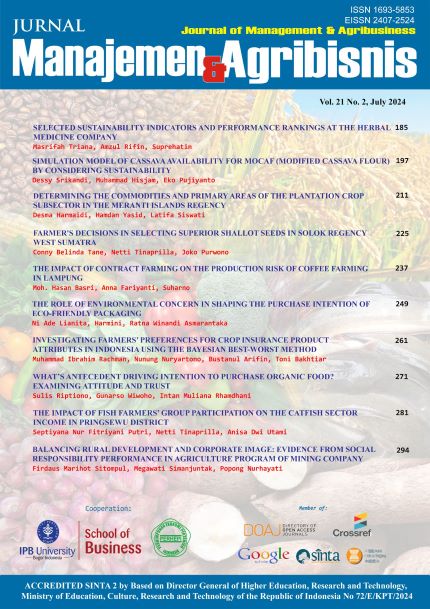What’s Antecedent Driving Intention To Purchase Organic Food? Examining Attitude and Trust
Abstract
Background: Organic food has its own appeal for consumers, so the development of the organic food business is currently rapid. Choosing the right food is the main key in maintaining health by living a healthy lifestyle.
Purpose: Thus, this research aims to examine antecedents that can increase consumer purchase intentions for organic food in Central Java.
Design/Methodology/approach: A total of 242 of organic food consumers as the respondent were involved to fill out the survey with a questionnaire determined based on purposive sampling techniques. The collected data was processed and analysed using structural equation models with the help of AMOS statistical tools.
Finding/Result: The research results prove that consumer purchase intentions for organic food are influenced by consumer attitudes and beliefs in organic food, but are not influenced by food safety concerns. Meanwhile, consumer trust in organic food is influenced by food safety concerns and health consciousness is not significant. Furthermore, attitude toward organic food is influenced by food safety concerns and health consciousness.
Conclusion: This research concludes that the antecedents used in this research have an important role in increasing consumer purchase intentions towards organic food.
Originality/value (state of the art): The originality of this research is that this research contributes to providing different insights regarding antecedents that can increase consumer purchasing intentions for organic food.
Keywords: green marketing, purchase intention, organic food, health consciousness, food safety
Authors
Authors who publish with this journal agree to the following terms:
- Authors retain copyright and grant the journal right of first publication with the work simultaneously licensed under a Creative Commons Attribution License that allows others to share the work with an acknowledgement of the work's authorship and initial publication in this journal.
- Authors are able to enter into separate, additional contractual arrangements for the non-exclusive distribution of the journal's published version of the work (e.g., post it to an institutional repository or publish it in a book), with an acknowledgement of its initial publication in this journal.
- Authors are permitted and encouraged to post their work online (e.g., in institutional repositories or on their website) prior to and during the submission process, as it can lead to productive exchanges, as well as earlier and greater citation of published work (See The Effect of Open Access).

